As I mentioned yesterday, last week Chris and I went to the Pergamon Museum in Berlin. According to the Internet, it’s one of the most visited museums in all of Germany, a fact which I found surprising, since it houses collections focussed on the Ancient Near East, with a bit of ancient Greek and Roman architecture thrown in. However, there were indeed crowds there last week; at one point, they even had to limit how many people were allowed in the museum, which led to a line down the columned corridor outside.
My favorite part of the museum was looking at all the things from Assyria, Babylon, and Anatolia. I studied Hittite for my Master’s Degree way back when, so it was fun to see some of the Hittite artifacts and clay tablets with the cuneiform on them (some of that was written in Hittite, some in other languages). It was astounding how small the cuneiform symbols were on some of those tablets – talk about it being hard to try to read that “fine print”! Not that I can read any cuneiform anymore, you understand, but it was fun to see them just the same.
BTW, the cuneiform tablets had the letters inscribed into them, so that the letters are indented into the tablet. I’ve included a photo of an Assyrian tablet in the gallery below that uses a later writing system with Aramaic lettering (and alphabet) and a different type of inscribing: the letters are “raised”, not indented on the table.
Before you ask, no, I don’t know how they did that.
I also enjoyed seeing a large collection of small cylindrical “stamps” (i.e. like the stamps used to seal documents with wax elsewhere). These cylinders were intricately carved so that when you rolled one on a piece of clay, an intricate picture was formed. In the gallery below, I included a shot of a case that had several of them on pedestals with a mirrors behind them so that you could see the rest of the carving. In the mirror in one image, you’ll see my hands reflected in the mirrors behind the seals, which provides a nice sense of scale to the seal. I’ve also included a version of that image with my hands removed – that’s the power of the digital darkroom. 😉
One of the main attractions at the museum is the reconstruction of the Ishtar Gate of Babylon. It’s an impressive structure made of blue decorated titles. You’ll see a photo of it in the gallery below. I decided not to try to get a photo without any people in it, as there were people everywhere, so my photo at least captures the experience of seeing it in a crowd, if not the perfect photo of the Ishtar Gate itself. I’ve included a photo of the little model of what they think the whole gate looked like, too; the reconstructed version in the museum is only of the smaller (i.e. not as tall) outer wall of the original structure. The reconstruction is interesting; in person, it’s easy to spot which tiles are original, and which are “new” to fill in the gaps. Having a reconstruction like that gives you an overall impression of what the gate could have looked like. Of course, this “new” gate is inside a room, and removed from any kind of context in terms of the environment it would have been in erected in. But still, interesting to see.
And, it also made it clear that the decorations on the tiles (like of the Auroch in the photo gallery below) were raised, and not flush with the rest of the wall. Cool.
The museum also presented a reconstructed palace room from the Assyrian palace of King Nebuchadnezzar II. This reconstruction was less successful than that of the Ishtar Gate, IMHO, since the audio guide (which overall was pretty good and included in the price of the ticket) said that the room was a good representation of what it would have looked like, except for the lighting, since the museum room had windows which the palace did not. And except for the fact that they had stuff from different centuries scattered around the room. I remember listening to the guide and thinking that the room really wasn’t that representative of the original room at all. Ah well.
Also, the two winged guardian figures on either side of the doorway in that room (it’s in one of the photos below) are plaster cast models of the real ones; the real ones are housed at the British Museum in London. That for me was actually an odd thing about the Pergamon: there were a lot of plaster cast models of ancient objects and tablet fragments, more than I would have expected. Perhaps when things got divided up between different museums at one point, the museums that wound up without the real stuff made do with the plaster casts of those things instead.
Now, the Victoria and Albert Museum in London actually has a whole gallery of these kinds of plaster models; and often, the plaster models of ancient columns and decorations on buildings winds up being the only surviving version of it, as weather and time takes it toll on things. So, it’s not that I object in general to plaster casts. But still, I didn’t expect the Pergamon, a museum noted for having so many authentic treasures, to present so many plaster versions of them instead of the real thing.
Anyway, the name of the museum comes from the Pergamon Altar, a massive Greek temple built around B.C. 150 in Anatolia (now Turkey). It was excavated in the 1800s and brought to Berlin in the early 20th century; the Pergamon museum was built specifically to house it in its reconstructed form. It’s therefore one of the major parts of the collection at the museum, and as a former Classics major, you’d have thought I’d be really excited by this altar. As it turned out, though, this was actually one of the things both Chris and I were least excited by at the museum. I found the room rather depressingly sterile that the altar is housed in, so it was a bit of a disappointment somehow. I think the fact that it’s enclosed in a room with a ceiling only slightly higher than the top of the temple fails to inspire the feeling that it looming over you outdoors would have had.
But perhaps that’s something that will be improved over the next few years. The part of the museum that holds the Pergamon Altar will be closing in September 2014 for renovation. I think it’s scheduled to be closed for years, so if you want to see it in person in its current state, plan accordingly. Renovations are currently going on in other parts of the museum which are closed at the moment. I read online today that those improvements were supposed to have been completed in 2010, so I guess they are running just a behind schedule.
Anyway, I didn’t take a single photo of the Pergamon Altar; you can see photos of it on this website if you want to check it out. However, in the photo gallery below you will find photos of a few of the things that caught my eye at the Pergamon Museum.
- Ishtar Gate of Babylon
- Model of the complete Ishtar Gate of Babylon
- Auroch (bull-like animal), Ishtar Gate of Babylon
- Lions, Ishtar Gate of Babylon ceremonial walkway
- Reconstructed Assyrian palace room
- Decorated shell
- Assyrian fragment with Aramaic writing and figure
- Cuneiform tablet
- Wall mosaics from Ur, a city in ancient Assyria
- Assyrian statue with eyes
- Assyrian statue with empty eye sockets
- Cylindrical Stamp #1
- Cylindrical Stamp #2
- Cylindrical Stamps – with hands of the photographer in back
- Cylindrical Stamps w/o the hands in the background

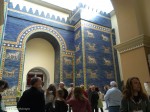
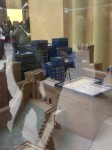
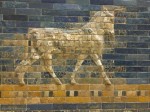

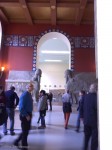
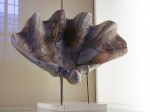
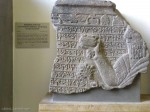
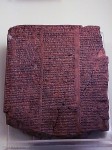
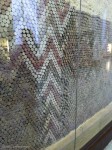
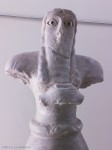
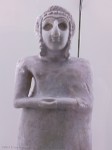
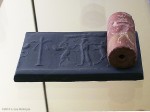

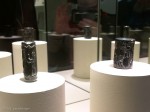
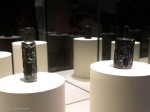
We have been to the Pergamon and have always liked their tile work. However, I don’t remember the cylindrical stamps at all and I liked them! However, I liked the decorated shell the best…like scrimshaw.
Well, since you studied Hittite for your Master’s, let me begin this comment in Hittite: i-pu-uli i-na-an-na at-ta te-pu-ush ku-la-u-tam Pergamon.
Furthermore, your photos really do justice to one of the most exciting museums in the world.